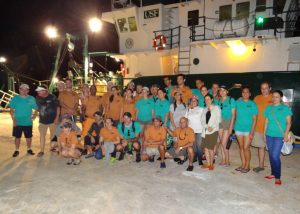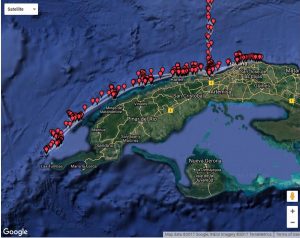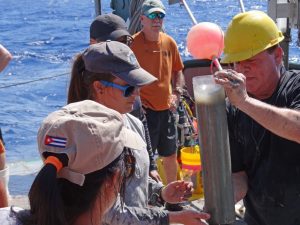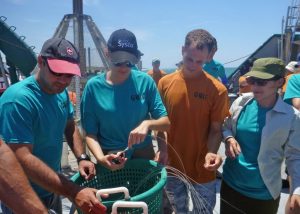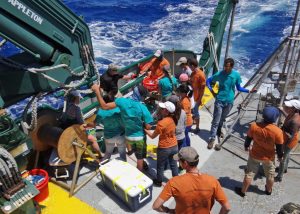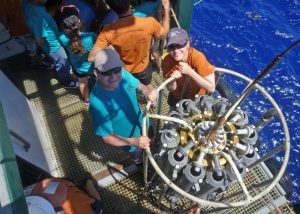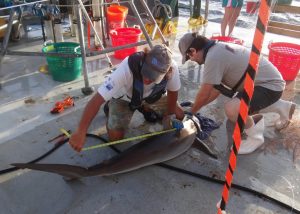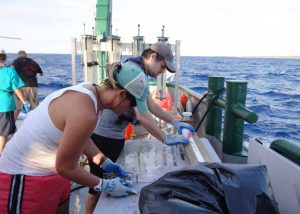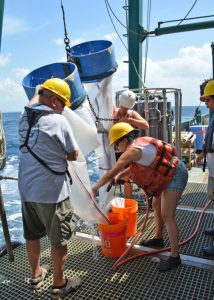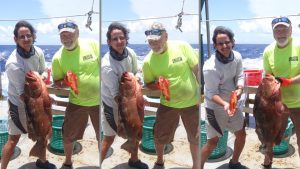Science at Sea: U.S. and Cuban Scientists Collaborate in Historic OneGulf Expedition
– JULY 20, 2017
Gulf-wide baseline for oil pollution monitoring complete!
Marine scientists advanced academic relations between the U.S. and Cuba during an 18-day research expedition (May 8-25) off the northwest coast of the island nation. Twenty-four scientists representing four universities sailed on the R/V Weatherbird II and collected 450 fish, 50 plankton, 150 water, and 1,500 sediment samples. They also tagged and released sharks.
The team will add the suite of samples from Cuban waters to collections gathered over the past four years from across the Gulf of Mexico. Now, with a comprehensive catalogue of environmental baseline specimens complete, scientists will be able to determine the presence of petroleum chemical signatures and better understand ecological impacts of future oil spills.
The U.S. team includes members of the Center for Integrated Modeling and Analysis of Gulf Ecosystems (C-IMAGE) consortium led by Steven Murawski of the University of South Florida (USF) who served as the expedition’s co-chief scientist. Researchers represented USF, Eckerd College, Texas A&M University – Corpus Christi, and Florida State University. The Cuban team was led by Maickel Armenteros, the expedition’s other co-chief scientist, with the University of Havana’s Centro de Investigaciones Marinas and included researchers from Centro de Estudios Ambientales de Cienfuegos.
The baseline samples off Cuba are particularly important because, unlike U.S. and Mexican waters, there is only a very small marine oil and gas industry there. “The importance of this expedition cannot be overemphasized,” explained Murawski. “Not only will it provide important clues as to the true environmental oil pollution baselines for the Gulf, but it provides important new and hopefully enduring connections to the vibrant Cuban marine science community.”
The U.S. team hosted 21 Cuban graduate students aboard the R/V Weatherbird II to participate in sample collection and field research, interact with other Gulf researchers, and gain experience with modern oceanographic sampling techniques; many of these students have never been on research vessels off shore.
Most students were from the Center for Marine Research at the University of Havana. Others were from the Center for Environmental Studies of Cienfuegos, the Center for Fisheries Research, Cuban Ministry of the Food Industry, National Aquarium of Cuba, the Center for Research on Coastal Ecosystems, and Geocuba Marine Studies. Co-chief scientist Armenteros summarized the student’s activities, “The opportunity to have our graduate students work offshore to gather samples and learn about the latest techniques of oceanographic research brings their classroom activities alive, and there is no substitute for such field activities. We look forward to additional joint research opportunities with our American colleagues.”
Cuban researchers have previously hosted marine science students from the U.S. Eckerd College has offered culturally- and scientifically-based specialty or “winter term” classes in Cuba. The Harte Research Institute at Texas A&M University-Corpus Christi has a number of joint marine research projects underway. “These opportunities hopefully establish a foundation for larger, more comprehensive future collaborations of mutual benefit to both countries,” observed Murawski.
C-IMAGE leadership planned this expedition after the 2015 signing of the Joint Statement between the United States of America and the Republic of Cuba on Cooperation on Environmental Protection. The joint statement emphasized the importance of collaboration on marine environmental issues, environmental regulations to prevent oil spills and hazardous substances pollution, and oil spill preparedness and recovery and response.
This expedition culminates a multi-year, international data collection effort that includes environmental samples from the Deepwater Horizon and Ixtoc I oil spills. “This is a successful example of science diplomacy,” reflected Murawski. “Without GoMRI’s funding and support throughout the years, this dataset would have never been collected. The international collaborations with the U.S., Mexico, and Cuba have shown us the importance of including our international partners in a One Gulf approach.”
Ship blogs from researchers are being released bi-weekly to highlight their research and share their experiences: Cruise Blog and Photo Gallery. Learn more about C-IMAGE research: OneGulf Voyage Gathers Unprecedented Marine Samples for Two Oil Spills.
************
This research was made possible in part by a grant from the Gulf of Mexico Research Initiative (GoMRI) to the Center for the Integrated Modeling and Analysis of Gulf Ecosystems II (C-IMAGE II).
The Gulf of Mexico Research Initiative (GoMRI) is a 10-year independent research program established to study the effect, and the potential associated impact, of hydrocarbon releases on the environment and public health, as well as to develop improved spill mitigation, oil detection, characterization and remediation technologies. An independent and academic 20-member Research Board makes the funding and research direction decisions to ensure the intellectual quality, effectiveness and academic independence of the GoMRI research. All research data, findings and publications will be made publicly available. The program was established through a $500 million financial commitment from BP. For more information, visit https://gulfresearchinitiative.org/.
© Copyright 2010-2017 Gulf of Mexico Research Initiative (GoMRI) – All Rights Reserved. Redistribution is encouraged with acknowledgement to the Gulf of Mexico Research Initiative (GoMRI). Please credit images and/or videos as done in each article. Questions? Contact web-content editor Nilde “Maggie” Dannreuther, Northern Gulf Institute, Mississippi State University (maggied@ngi.msstate.edu).

